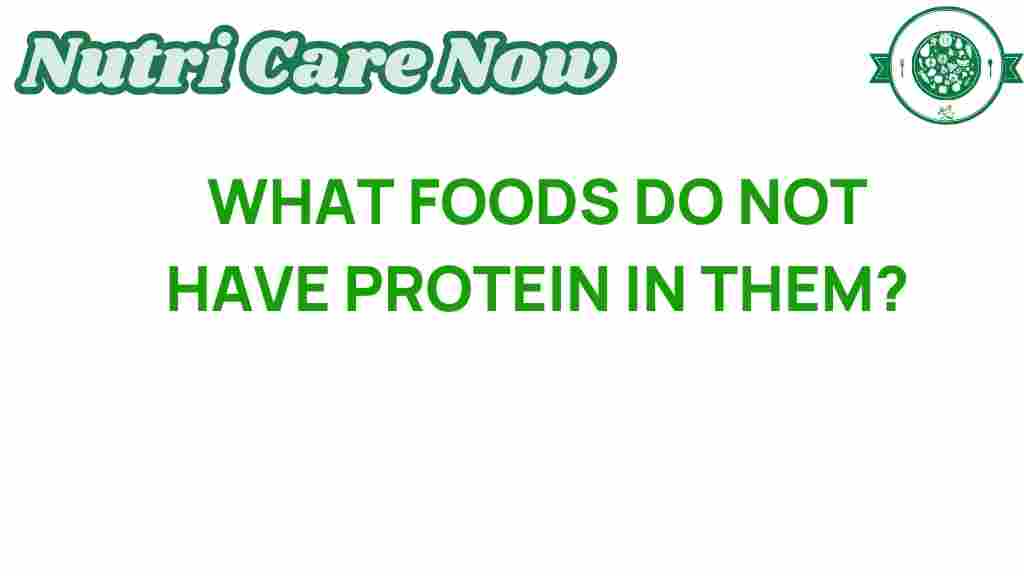Unmasking the Hidden Truth: Foods That Lack Protein
When it comes to nutrition, protein is often heralded as one of the essential macronutrients that our bodies need to function optimally. However, in the midst of all the protein-focused diets and meal plans, there are foods that lack protein, which can be easily overlooked. Understanding these protein-free foods is crucial for making informed dietary choices, especially for those on a vegan diet or looking to enhance their food awareness. In this article, we will delve deep into the various foods that are devoid of protein, how they fit into a healthy eating plan, and tips for meal planning without compromising on nutrition.
Understanding Protein and Its Importance
Before we unmask the hidden truth about protein-free foods, let’s briefly discuss what protein is and why it is vital for our health. Protein is made up of amino acids, which are the building blocks of our body. It plays several roles, including:
- Building and repairing tissues
- Producing enzymes and hormones
- Supporting immune function
- Providing energy when carbohydrates and fats are not available
Given these benefits, it is essential to monitor our protein intake, especially if we are limiting ourselves to certain food groups. Now, let’s explore the foods that might be lacking in protein.
Identifying Protein-Free Foods
Being aware of protein-free foods can help you make better dietary choices. Here’s a comprehensive list of foods that typically contain little to no protein:
- Sugary Snacks: Candies, cakes, and cookies often have high sugar content but lack protein.
- Fruits: While fruits are packed with vitamins and minerals, most fruits are low in protein. Examples include:
- Apples
- Oranges
- Bananas
- Berries
- Starchy Vegetables: Potatoes and corn are rich in carbohydrates but have minimal protein.
- Refined Grains: White bread, pasta, and rice contain very little protein compared to whole grains.
- Fats and Oils: Foods like butter, oils, and lard are composed mainly of fats and contain no protein.
- Non-Dairy Creamers: Many non-dairy creamer options are devoid of protein.
How to Incorporate Protein in Your Diet
For individuals who are mindful of their protein intake or those following a vegan diet, it is essential to find ways to include protein-rich foods in their meals. Here are some health tips:
- Include Legumes: Beans, lentils, and chickpeas are excellent sources of protein and should be included in your diet.
- Opt for Whole Grains: Choose brown rice, quinoa, and whole grain bread to increase your protein intake.
- Incorporate Nuts and Seeds: Almonds, chia seeds, and flaxseeds can add protein and healthy fats to your meals.
- Consider Plant-Based Proteins: Tofu, tempeh, and edamame are great alternatives for vegans looking to boost their protein intake.
Meal Planning for Optimal Nutrition
Effective meal planning is key to ensuring you receive an adequate amount of protein while still enjoying a variety of foods. Here’s a step-by-step process for meal planning:
- Assess Your Needs: Determine how much protein you need based on your age, activity level, and dietary preferences.
- Select Protein Sources: Choose a variety of protein sources, including legumes, whole grains, nuts, and seeds.
- Create Balanced Meals: Aim for meals that include a protein source, healthy fats, and a variety of fruits and vegetables.
- Prepare Ahead: Cook larger batches of beans, grains, and protein-rich foods to use throughout the week.
- Stay Flexible: Allow for adjustments in your meal plan based on what’s available and your cravings.
Common Pitfalls and Troubleshooting Tips
While being aware of protein-free foods is important, there are some common pitfalls that individuals may encounter while trying to maintain a balanced diet. Here are some troubleshooting tips:
- Relying Too Much on Processed Foods: Many processed foods lack protein and are high in sugar. Focus on whole foods for better nutrition.
- Neglecting Meal Prep: Without meal prepping, it’s easy to grab quick snacks that lack protein. Set aside time each week to prepare healthy meals.
- Ignoring Nutritional Labels: Always check labels for protein content, especially in packaged foods.
For more detailed information on nutrition and meal planning, consider visiting this comprehensive guide.
Conclusion
In conclusion, being informed about protein-free foods is essential for making better dietary choices and maintaining optimal health. By incorporating a variety of protein-rich foods into your meals, you can ensure that you are meeting your nutritional needs while enjoying a balanced diet. Whether you’re following a vegan diet or simply looking to enhance your food awareness, understanding the role of protein in your meals is a significant step toward healthy eating. Remember, meal planning is not just about what you eat, but also about how you prioritize your health through informed choices.
Stay aware, stay healthy!
This article is in the category Diet and created by NutriCareNow Team
